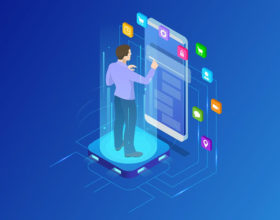What Does 2018 Hold in Store for Enterprise Mobile App Development?
 Enterprise mobility, for all its unexplored applicative territories, has been enjoying the buzzword status for a while now. Enterprises have not just begun investing but also been implementing the “bring your own device” (BYOD) philosophy across industries.
Enterprise mobility, for all its unexplored applicative territories, has been enjoying the buzzword status for a while now. Enterprises have not just begun investing but also been implementing the “bring your own device” (BYOD) philosophy across industries.
The concept was quite a “mind-boggling” one, till a few years back when companies relying on legacy systems found it quite an arduous task to keep up with the sudden upsurge of technological intervention into every sphere.
On the other hand, the concept is nothing less than quintessential today. The reason is pretty obvious as the workforce is exposed to a plethora of smart devices that not just boosts productivity, but the capacity of individuals to respond to the ever-increasing demands that have emerged as a byproduct of this ‘smart revolution’. Legacy systems seem to have become obsolete, while enterprise mobility is showing the way forward.
A distinct advantage of enterprise mobility is enabling employees to strike the right balance between work and life. Contrary to the earlier systems, “office life” and “personal life” no longer exist as distinct entities. Now there is an overlap. The flexibility that tagged along with BYOD allows both ‘work’ and ‘life’ to encroach into each other’s space to a large extent.
Enterprise mobility is but the tip of the iceberg that is enterprise mobile application development. In an age when we are looking at extensive process automation and decentralized information, enterprise mobile app development emerges as a powerful tool of digital transformation.
Over the course of time, enterprise applications have grown as a necessary competitive instrument for businesses. A report suggests that enterprise mobile application market value would soon hit a whopping GBP 60 bil lion.
Enterprise mobile applications are, however, not only restricted to business processes. The extensive implementations of enterprise mobile app development are gradually impacting the way brands communicate with their customers. From location-based services to instant feedback through machine-learning enabled chatbots, businesses are transforming customer interactions.
That being said, technology is an ever-evolving landscape. It is only obvious that enterprise mobile app development be part of the change and, in certain cases, spearhead it. Let’s take a look at how recent technological advancements are affecting the enterprise mobile app development scenario.
Tech Trends That Are Transforming Enterprise Mobile App Development

Containers and Microservices
Containers are one of the most efficient tools in the context of mobile app development. They are essentially logic components of the application that are equipped with minimal resources that are required to execute specific commands. One of the greatest advantages of using containers, in contrast to Virtual Machines, is that they do not require embedded operating systems. Actions that require operating system resources are accomplished by calling them through an application programming interface (API).
Microservices or microservice architecture, on the other hand, implements connected modular services to structure a complex application. This kind of architecture simplifies the deployment of complex applications and ensuring implementation of business capabilities.
The use of containers and microservice architecture are set to revolutionize the mobile app development movement by executing large enterprise applications with relative ease.
The Rise of Open-Source
There are various proprietary enterprise mobile app development platforms available for the implementing. However, businesses are increasingly making the shift towards an open-source approach to mobile app development. One of the major reasons for this shift is the flexibility granted by open-source.
In keeping with the need for scalability in enterprise applications, open-source allows the necessary agility to achieve this. Due to its nature, open source does not require the granting of permissions or licenses from the proprietor. This in turn increases the speed of development and implementing iterations throughout the lifecycle of the applications.
Another great advantage of open-source is its cost effectiveness. It is obvious that proprietary platforms allow certain functional advantages over open-source platforms. However, more often than not, it is possible to work around any given issue while working on open-source platforms. Open-source and its entailing advantages are increasingly instigating businesses to adopt it. The speed and cost-effective aspects grant a significant competitive advantage.
The Age of – as a Service: The introduction of cloud computing revolutionized the way businesses handle various process. With services like infrastructure (IaaS), platforms (PaaS), function (FaaS) and application platform (aPaaS) being provided over the cloud have significantly reduced cost burden on companies that would otherwise spend large amounts to build and maintain these in-house.
For non-tech enterprises, infrastructure costs can be a major influencing factor in the mobile app development process. By employing a shared service over the cloud like Application Platform as a Service (IaaS), companies are able to bypass the process of setting up their infrastructure from scratch by paying a nominal amount while availing all of their benefits.
Another major advantage of implementing the cloud for enterprise mobile app development lies in the multiple devices area. Through the cloud there is unilateral availability of data across various systems, allowing a modular approach to mobile app development.
AI in Mobile App Development
Personalization is where all the hype is for businesses looking to improve customer relationships. Artificial Intelligence is helping companies achieve this goal through mobile app development. It has been observed that as many as 23% users uninstall applications after just one use. One of the primary reason for this is the inability of applications to meet the user’s expectations.
However, through the use of AI, application can be made to provide the user with customized/personalized solutions based on their preferences. To that end, companies must ensure that their AI solutions are capable of executing the desired functions.
One of the most important factors in AI implementation is the availability of a strong data lake. A data lake system is indispensable for indexing and categorizing data. Needless to say, this requires streamlined data access, management, and distribution.
Rapid Application Development Platform (RADP)
 As discussed earlier, Platform as a Service is gaining momentum across the mobile app development space. Rapid Application Development platforms (RADP) are one of the most significant among these. By implementing a RADP businesses can ensure much higher speed of development. This in turn results in the cutdown in development costs.
As discussed earlier, Platform as a Service is gaining momentum across the mobile app development space. Rapid Application Development platforms (RADP) are one of the most significant among these. By implementing a RADP businesses can ensure much higher speed of development. This in turn results in the cutdown in development costs.
The use of modules in the mobile app development process allows these platforms to be highly iterative while reusing code components to reduce effort wastage. RAD platforms adopt a low-code methodology to mobile app development allowing the developer to design visually stunning UI/UX.
The greatest advantage of these platforms, however, lie in their capability to integrate disparate data systems with relative ease. Since, integrating the app with legacy systems and third-party software remains one of the most significant requirements for enterprises, this gives them a clear competitive advantage.





